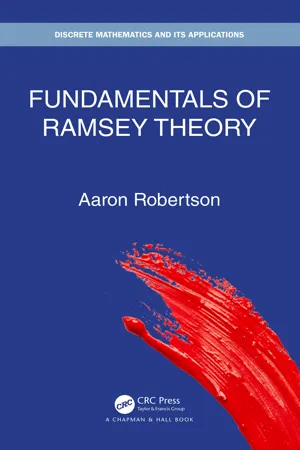
- 241 pages
- English
- ePUB (mobile friendly)
- Available on iOS & Android
Fundamentals of Ramsey Theory
About this book
Ramsey theory is a fascinating topic. The author shares his view of the topic in this contemporary overview of Ramsey theory. He presents from several points of view, adding intuition and detailed proofs, in an accessible manner unique among most books on the topic. This book covers all of the main results in Ramsey theory along with results that have not appeared in a book before.
The presentation is comprehensive and reader friendly. The book covers integer, graph, and Euclidean Ramsey theory with many proofs being combinatorial in nature. The author motivates topics and discussion, rather than just a list of theorems and proofs. In order to engage the reader, each chapter has a section of exercises.
This up-to-date book introduces the field of Ramsey theory from several different viewpoints so that the reader can decide which flavor of Ramsey theory best suits them.
Additionally, the book offers:
- A chapter providing different approaches to Ramsey theory, e.g., using topological dynamics, ergodic systems, and algebra in the Stone-?ech compactification of the integers.
-
- A chapter on the probabilistic method since it is quite central to Ramsey-type numbers.
-
- A unique chapter presenting some applications of Ramsey theory.
-
- Exercises in every chapter
The intended audience consists of students and mathematicians desiring to learn about Ramsey theory. An undergraduate degree in mathematics (or its equivalent for advanced undergraduates) and a combinatorics course is assumed.
TABLE OF CONENTS
Preface
List of Figures
List of Tables
Symbols
1. Introduction
2. Integer Ramsey Theory
3. Graph Ramsey Theory
4. Euclidean Ramsey Theory
5. Other Approaches to Ramsey Theory
6. The Probabilistic Method
7. Applications
Bibliography
Index
Biography
Aaron Robertson received his Ph.D. in mathematics from Temple University under the guidance of his advisor Doron Zeilberger. Upon finishing his Ph.D. he started at Colgate University in upstate New York where he is currently Professor of Mathematics. He also serves as Associate Managing editor of the journal Integers. After a brief detour into the world of permutation patterns, he has focused most of his research on Ramsey theory.
Frequently asked questions
- Essential is ideal for learners and professionals who enjoy exploring a wide range of subjects. Access the Essential Library with 800,000+ trusted titles and best-sellers across business, personal growth, and the humanities. Includes unlimited reading time and Standard Read Aloud voice.
- Complete: Perfect for advanced learners and researchers needing full, unrestricted access. Unlock 1.4M+ books across hundreds of subjects, including academic and specialized titles. The Complete Plan also includes advanced features like Premium Read Aloud and Research Assistant.
Please note we cannot support devices running on iOS 13 and Android 7 or earlier. Learn more about using the app.
Information
1
Introduction
1.1 What is Ramsey Theory?
Table of contents
- Cover
- Half Title
- Title Page
- Series Page
- Copyright Page
- Dedication
- Contents
- Preface
- Symbols
- 1 Introduction
- 2 Integer Ramsey Theory
- 3 Graph Ramsey Theory
- 4 Euclidean Ramsey Theory
- 5 Other Approaches to Ramsey Theory
- 6 The Probabilistic Method
- 7 Applications
- Bibliography
- Index